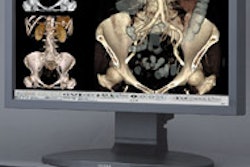The personal digital assistant (PDA) has become a ubiquitous part of modern professional life. From its humble beginnings as an address book and day planner, the device has blossomed into a multifunctional tool capable of voice and video recording, photo capture and storage, and data transmission and telephony.
According to two studies presented at the 2005 European Congress of Radiology (ECR) in Vienna, PDAs are fast becoming the latest addition to RIS/PACS hardware. First, a group from Ireland provided an assessment of currently available PDA technologies for RIS/PACS capabilities. Another researcher from Denmark shared his institution's experience with PDAs for primary reading in orthopedics.
Widespread use
Clinicians use PDAs for personal information management, patient note recording, voice recording of comments for transcription, and research via wireless Internet capabilities, according to Dr. Conor Meehan and colleagues from University College Hospital in Galway, Ireland.
Voice recording for reports is a standard feature of many PDAs and many commercially available applications are available, they reported.
"Clinicians are becoming more and more demanding of access to imaging studies, as aids to diagnosis and planning of treatment, and as education aids at the bedside for both patients and medical students," the group stated.
In addition, they observed that "radiologists with heavy administrative workloads may find themselves in transit or away from the office for extend periods. PDAs combine portability and performance to offer a solution wherein images may be stored in a portable device for later viewing."
Display
One of the greatest limitations on the use of PDAs for viewing radiology images has been the display. Most Palm (PalmOne, Sunnyvale, CA) or Pocket PC (Microsoft, Redmond, WA) PDA devices have made do with 320 x 400-pixel viewing areas. The picture has improved with recent models offering VGA-quality screens with 640 x 480-pixel viewing areas, which should permit the display of 512 x 512 matrix images, the authors noted. Options are also available to shift the screen display from portrait to landscape configuration.
The Irish researchers said that active matrix liquid crystal pixel displays (AMLCD) are often limited to an 8-bit scale luminance output. They maintain that a deeper grayscale resolution can be achieved by either subpixel modulation or temporal modulation.
In subpixel modulation, subpixel regions designed for color applications are used to generate a lookup table, which in turn is used to provide greater depth to the grayscale. Temporal modulation uses much the same technology as motion picture projection, by combining the luminance of two distinct luminance levels in two consecutive frames of the image.
"Because the frame rate is high, human observers cannot discriminate between consecutive frames and therefore experience an average pixel luminance," the authors wrote.
CPU
Slow processing speeds are another limitation to PDAs, the researchers said. With the explosion in multidetector CT (MDCT) studies in the past few years, RIS/PACS workstation processors have also been ramped up to help compensate for the large datasets. PDAs have seen their own increases in processor speeds, with the fastest devices now pushing 624 MHz. This is still a long way from the 2+ GHz speeds found in many laptop and desktop computers, however.
Storage
Lossless compression is widely regarded as the compression standard for diagnostic image viewing. MR, ultrasound video, MDCT, and 3D volumetric imaging have the capability of creating single studies that are hundreds of megabytes in size. As such, additional storage capacity is necessary for PDAs to function in the RIS/PACS enterprise.
Currently, multigigabyte storage card technology seems the most promising answer to DICOM image storage needs for PDAs. Two gigabyte cards are now commercially available, and 4-5 GB cards will likely hit the market within a year or so, the authors wrote.
Another promising storage schema noted by the researchers was digital-audio technology, such as the iPod (Apple Computer, Sunnyvale, CA). Some models of this device have 40 GB data-storage capacities in a form factor similar in size to PDAs.
Connectivity
The need for speed in data transmission is critical with radiology's large datasets. PDA wireless technology, although robust for many applications, may not yet have the muscle necessary for radiology's heftiest studies.
The researchers observed that the latest iteration of Bluetooth for PDAs, version 1.2, offers connectivity speeds up to 10 Mbps, which would be unacceptable for a 300 MB MDCT study. Wireless high-speed networks show greater promise, with speeds of greater than 50 Mbps possible.
Applications
RIS/PACS software for PDAs is breaking out, with some commercial offerings now available, and others in development. Among the vendors marketing PDA-based products is Italian software development firm Puntoexe of Palermo, which offers its DicomViewer PDA application for the PocketPC at a price point of $59. The application features color lookup tables, as well as contrast, center, and width adjustments; handles multiframe DICOM files; and handles up to 16 bits per color channel.
Digisoft, of Jenkintown, PA, develops reViewMD PDA software for the PocketPC. The $895.95 DICOM 3-compliant application provides a broad complement of image management tools, such as real-time contrast and brightness adjustment with preview window, zoom, annotations, screen capture, video display and capture capabilities, and picture rotation.
PDA readings
Medical Insight of Hovedgaden, Denmark, has installed its EasyViz RIS/PACS application at Aalborg University Hospital in Aalborg, Denmark. The product provides RIS and PACS functionality throughout the facility via PocketPC PDAs, as well as traditional hard-wired workstations, said Dr. Henrik Gregersen.
For his study, readings were conducted first on a workstation (two types of workstation from two vendors), then on a wireless PDA (Compaq iPAQ 4500, HP, Palo Alto, CA) with a period of one to three weeks between the two readings. One radiologist completed both readings.
The results showed that 95% of 45 orthopedic cases (CT, MR, CR, and DR) reviewed in Gregersen's study of the PDA application produced primary readings in full agreement with those performed on a diagnostic workstation.
The challenges ahead
According to the Irish research team, PDA manufacturers and software developers for the portable RIS/PACS are facing five challenges: battery life; balancing screen size and display quality with portability; storage capacity; security; and rapid and secure connectivity. However, they believe that the demand for anytime, anywhere access to radiological images will drive the development of PDA technology to meet these challenges.
By Jonathan S. Batchelor
AuntMinnie.com contributing writer
May 13, 2005
Related Reading
AuntMinnieTV: PACS software streams images to PDAs, March 25, 2005
Skyscape, Satellife refit PDAs for African doctors, December 9, 2004
Mobile phones show promise for remote image viewing, September 1, 2004
Mobile computing aids ED/radiology communications, August 6, 2004
PDAs do little to reduce documentation discrepancies, March 18, 2004
Copyright © 2005 AuntMinnie.com



















